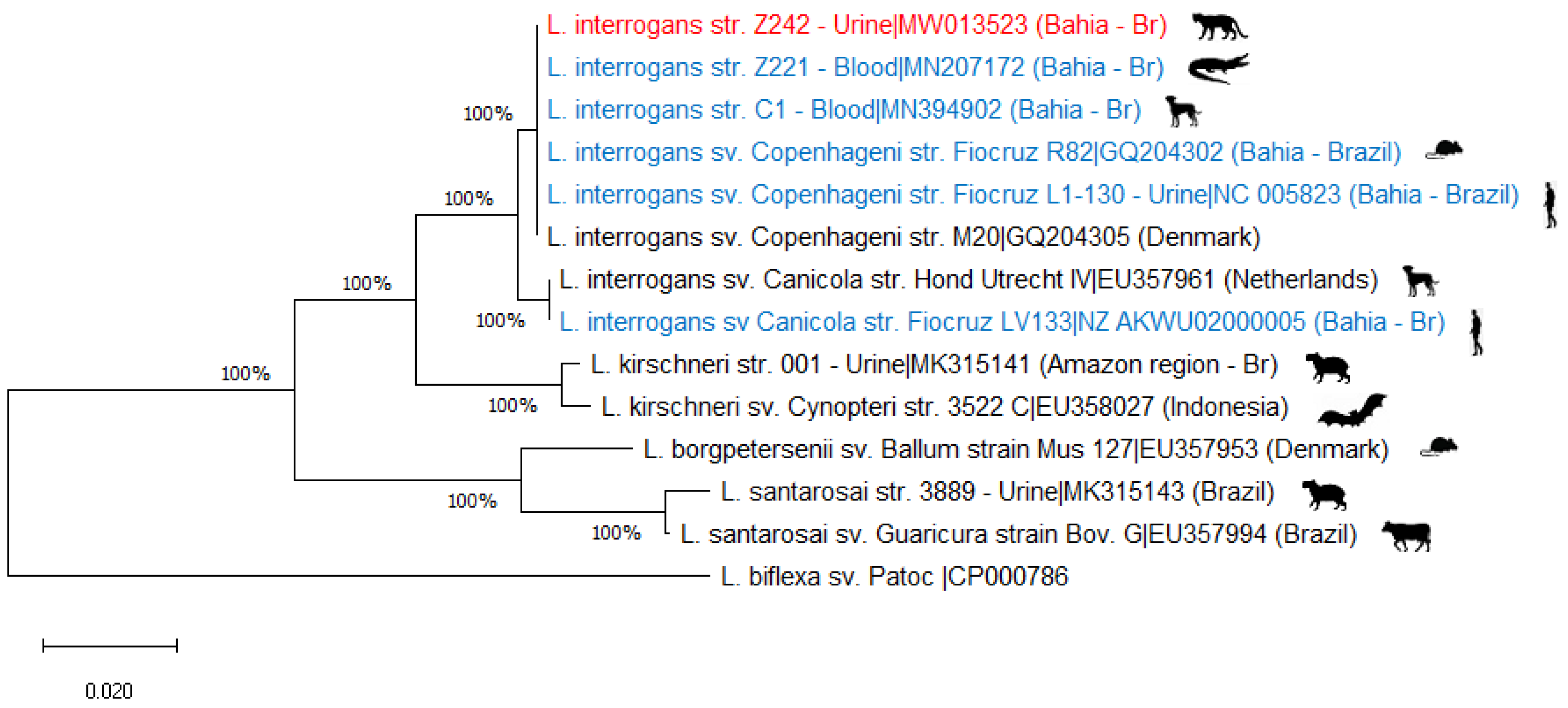Detection of Leptospira interrogans DNA in Urine of a Captive Ocelot (Leopardus pardalis)
Supplementary Materials
Author Contributions
Funding
Institutional Review Board Statement
Acknowledgments
Conflicts of Interest
References
- Murillo, A.; Cuenca, R.; Serrano, E.; Marga, G.; Ahmed, A.; Cervantes, S.; Caparrós, C.; Vieitez, V.; Ladina, A.; Pastor, J. Leptospira Detection in Cats in Spain by Serology and Molecular Techniques. Int. J. Environ. Res. Public Health 2020, 17, 1600. [Google Scholar] [CrossRef] [PubMed]
- Alashraf, A.R.; Lau, S.F.; Khor, K.H.; Khairani-Bejo, S.; Bahaman, A.R.; Roslan, M.A.; Rahman, M.S.A.; Goh, S.H.; Radzi, R. Serological Detection of Anti-Leptospira Antibodies in Shelter Cats in Malaysia. Top. Companion Anim. Med. 2019, 34, 10–13. [Google Scholar] [CrossRef] [PubMed]
- Sprißler, F.; Jongwattanapisan, P.; Luengyosluechakul, S.; Pusoonthornthum, R.; Prapasarakul, N.; Kurilung, A.; Goris, M.; Ahmed, A.; Reese, S.; Bergmann, M.; et al. Leptospira infection and shedding in cats in Thailand. Transbound. Emerg. Dis. 2019, 66, 948–956. [Google Scholar] [CrossRef] [PubMed]
- Onuma, S.S.M.; Kantek, D.L.Z.; Crawshaw Júnior, P.G.; Morato, R.G.; May-Júnior, J.A.; de Morais, Z.M.; Ferreira Neto, J.S.; de Aguiar, D.M. Detection of Leptospira spp. and Brucella abortus antibodies in free-living jaguars (Panthera onca) in two protected areas of Northern Pantanal, Brazil. Rev. Inst. Med. Trop. Sao Paulo 2015, 57, 177–180. [Google Scholar] [CrossRef] [PubMed]
- Furtado, M.M.; Gennari, S.M.; Ikuta, C.Y.; Jácomo, A.T.d.A.; de Morais, Z.M.; Pena, H.F.d.J.; de Porfírio, G.E.O.; Silveira, L.; Sollmann, R.; de Souza, G.O.; et al. Serosurvey of Smooth Brucella, Leptospira spp. and Toxoplasma gondii in Free-Ranging Jaguars (Panthera onca) and Domestic Animals from Brazil. PLoS ONE 2015, 10, e0143816. [Google Scholar] [CrossRef] [PubMed]
- Iatta, R.; Natale, A.; Ravagnan, S.; Mendoza-Roldan, J.; Zatelli, A.; Cavalera, M.A.; Nachum-Biala, Y.; Baneth, G.; Otranto, D. Zoonotic and vector-borne pathogens in tigers from a wildlife safari park, Italy. Int. J. Parasitol. Parasites Wildl. 2020, 12, 1–7. [Google Scholar] [CrossRef] [PubMed]
- Ullmann, L.S.; Hoffmann, J.L.; de Moraes, W.; Cubas, Z.S.; dos Santos, L.C.; da Silva, R.C.; Moreira, N.; Guimaraes, A.M.S.; Camossi, L.G.; Langoni, H.; et al. Serologic survey for Leptospira spp. in captive neotropical felids in Foz do Iguaçu, Paraná, Brazil. J. Zoo Wildl. Med. 2012, 43, 223–228. [Google Scholar] [CrossRef] [PubMed]
- Lilenbaum, W.; Monteiro, R.V.; Albuquerque, C.E.; Ristow, P.; Fraguas, S.; Cardoso, V.S.; Fedullo, L.P.L. Leptospiral antibodies in wild felines from Rio de Janeiro Zoo, Brazil. Vet. J. 2004, 168, 191–193. [Google Scholar] [CrossRef]
- Ellis, W.A. Animal Leptospirosis. In Leptospira and Leptospirosis, Current Topics in Microbiology and Immunology; Adler, B., Ed.; Springer: Berlin/Heidelberg, Germany, 2015; Volume 387, pp. 99–137. [Google Scholar]
- Alashraf, A.R.; Lau, S.F.; Khairani-Bejo, S.; Khor, K.H.; Ajat, M.; Radzi, R.; Roslan, M.A.; Rahman, M.S.A. First report of pathogenic Leptospira spp. Isolated from urine and kidneys of naturally infected cats. PLoS ONE 2020, 15, e0230048. [Google Scholar] [CrossRef] [PubMed]
- OIE Leptospirosis. Manual of Diagnostic Tests and Vaccines for Terrestrial Animal; OIE: Paris, France, 2018; Volumes 1–3, pp. 503–516. ISBN 78-92-95108-18-9. [Google Scholar]
- Paz, L.N.; Hamond, C.; Dias, C.S.; Curvelo, V.P.; Medeiros, M.A.; Oriá, A.P.; Pinna, M.H. Detection of Leptospira spp. in Captive Broad-Snouted Caiman (Caiman latirostris). Ecohealth 2019, 16, 694–700. [Google Scholar] [CrossRef] [PubMed]
- Tamura, K.; Stecher, G.; Peterson, D.; Filipski, A.; Kumar, S. MEGA6: Molecular evolutionary genetics analysis version 6.0. Mol. Biol. Evol. 2013, 30, 2725–2729. [Google Scholar] [CrossRef] [PubMed]
- Fornazari, F.; Langoni, H.; Marson, P.M.; Nóbrega, D.B.; Teixeira, C.R. Leptospira reservoirs among wildlife in Brazil: Beyond rodents. Acta Trop. 2018, 178, 205–212. [Google Scholar] [CrossRef] [PubMed]
- Weis, S.; Rettinger, A.; Bergmann, M.; Llewellyn, J.R.; Pantchev, N.; Straubinger, R.K.; Hartmann, K. Detection of Leptospira DNA in urine and presence of specific antibodies in outdoor cats in Germany. J. Feline Med. Surg. 2016. [Google Scholar] [CrossRef] [PubMed]
- Hagan, J.E.; Moraga, P.; Costa, F.; Capian, N.; Ribeiro, G.S.; Wunder, E.A.; Felzemburgh, R.D.M.; Reis, R.B.; Nery, N.; Santana, F.S.; et al. Spatiotemporal Determinants of Urban Leptospirosis Transmission: Four-Year Prospective Cohort Study of Slum Residents in Brazil. PLoS Negl. Trop. Dis. 2016, 10, e0004275. [Google Scholar] [CrossRef] [PubMed]
- Felzemburgh, R.D.M.; Ribeiro, G.S.; Costa, F.; Reis, R.B.; Hagan, J.E.; Melendez, A.X.T.O.; Fraga, D.; Santana, F.S.; Mohr, S.; dos Santos, B.L.; et al. Prospective Study of Leptospirosis Transmission in an Urban Slum Community: Role of Poor Environment in Repeated Exposures to the Leptospira Agent. PLoS Negl. Trop. Dis. 2014, 8, e2927. [Google Scholar] [CrossRef] [PubMed]
- Casanovas-Massana, A.; Costa, F.; Riediger, I.N.; Cunha, M.; de Oliveira, D.; Mota, D.C.; Sousa, E.; Querino, V.A.; Nery, N.; Reis, M.G.; et al. Spatial and temporal dynamics of pathogenic Leptospira in surface waters from the urban slum environment. Water Res. 2018, 130, 176–184. [Google Scholar] [CrossRef] [PubMed]

Publisher’s Note: MDPI stays neutral with regard to jurisdictional claims in published maps and institutional affiliations. |
© 2021 by the authors. Licensee MDPI, Basel, Switzerland. This article is an open access article distributed under the terms and conditions of the Creative Commons Attribution (CC BY) license (http://creativecommons.org/licenses/by/4.0/).
Share and Cite
Paz, L.N.; Hamond, C.; Pinna, M.H. Detection of Leptospira interrogans DNA in Urine of a Captive Ocelot (Leopardus pardalis). Int. J. Environ. Res. Public Health 2021, 18, 793. https://doi.org/10.3390/ijerph18020793
Paz LN, Hamond C, Pinna MH. Detection of Leptospira interrogans DNA in Urine of a Captive Ocelot (Leopardus pardalis). International Journal of Environmental Research and Public Health. 2021; 18(2):793. https://doi.org/10.3390/ijerph18020793
Chicago/Turabian StylePaz, Lucas N., Camila Hamond, and Melissa H. Pinna. 2021. "Detection of Leptospira interrogans DNA in Urine of a Captive Ocelot (Leopardus pardalis)" International Journal of Environmental Research and Public Health 18, no. 2: 793. https://doi.org/10.3390/ijerph18020793
APA StylePaz, L. N., Hamond, C., & Pinna, M. H. (2021). Detection of Leptospira interrogans DNA in Urine of a Captive Ocelot (Leopardus pardalis). International Journal of Environmental Research and Public Health, 18(2), 793. https://doi.org/10.3390/ijerph18020793





